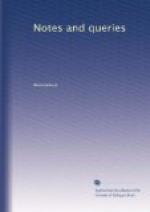That they were both living in 1668 is proved by a petition in the State Paper Office (Read in Council, Ap. 8, 1688. Trade Papers, Verginia, No. I. A.):—“To the King’s most excellent Ma’tie and the rt. hon’ble the Lords of his Maj. most hon’ble Privy Councel,” from “Grace, the wife of Humphry Walrond, Esq.” In this petition she states that her husband had been very severely prosecuted by Lord Willoughby, whose sub-governor he had been in Barbadoes. “He had contracted many debts by reason of his loyalty and suffering in the late troubles, to the loss of at least thirty thousand pounds.” “That his loyalty and sufferings are notoriously known, both in this kingdom and the Barbadoes, where he was banished for proclaiming your Ma’tie after the murder of your royal father.” Colonel Walrond is mentioned by Clarendon, Rushworth, Whitelock, &c.; but of the date of his death, the maiden name of his wife, and the Christian names of all his ten children, I can find no account.
The arms S.S.S. inquires about on the monument {285} of Humphry Walrond, Esq., in Ilminster Church, are those of the family of Brokehampton. Humphry Walrond (who died 1580) married Elizabeth, daughter and coheir of John Brokehampton., of Sea, and so obtained that estate.
W. DOWNING BRUCE.
Middle Temple.
Blackguard (Vol. ii., p. 134.).—An early instance of the use of this word occurs in a letter from Richard Topcliffe (Aug. 30, 1578), printed in Lodge’s Illustrations, vol. ii. p. 188. I quote from Mr. Jardine’s Criminal Trials, vol. ii. p. 13.: “His house, Euston, far unmeet for her Highness, but fitter for the Black Guard.”
It also occurs in Fuller’s Church History (Book ix. cent. xvi. sect. vii. Sec. 35. vol. v. p. 160. ed. Brewer):—“For who can otherwise conceive but such a prince-principal of darkness must be proportionably attended with a black guard of monstrous opinions?”
J.E.B. MAYOR.
Scala Coeli (Vol. i., pp. 366. 402. 455.).—Maundrell mentions, “at the coming out of Pilate’s house, a descent, where was anciently the Scala Sancta.” (Journey from Aleppo to Jerusalem, p. 107.) This holy or heavenly stair was that by which the Redeemer was led down, by order of Pilate, according to the legend, and afterwards was, among other relics, carried to Rome. It is now in the Church of St. John Lateran, whither it is said to have been brought by St. Helena from Jerusalem. Pope Alexander Vl., and his successor Julius, granted to the Chapel of St. Mary built by King Henry VII., in Westminster Abbey—




